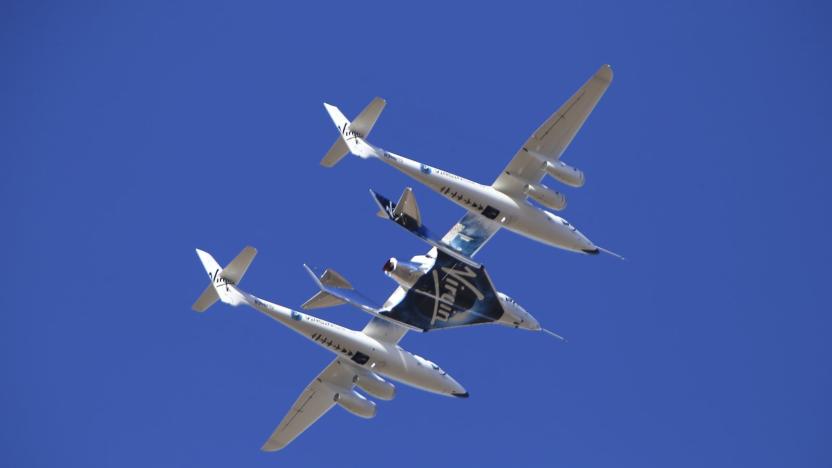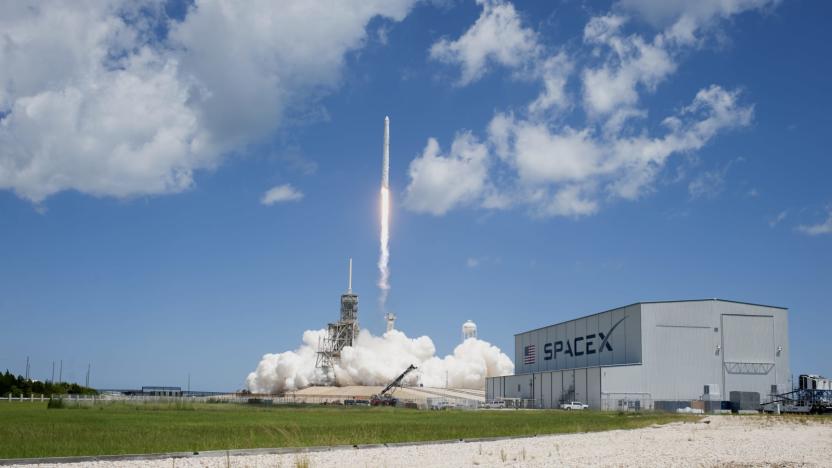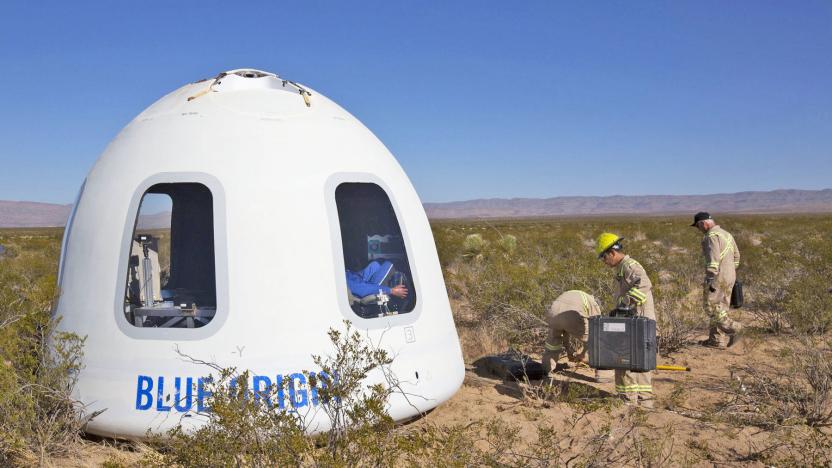CommercialSpaceTravel
Latest

Virgin Galactic sends its first passenger to the edge of space
Virgin Galactic sent its first test passenger into sub-space today. The company's chief astronaut instructor Beth Moses accompanied two pilots on a flight 55.85 miles above the Earth, just a few miles below the internationally recognized space boundary, 62 miles. This will likely come as good news to the more than 600 people from 58 countries who have paid or put down deposits for suborbital flights with Virgin Galactic -- some of those passengers have been queuing for as many as 14 years.
Christine Fisher02.22.2019
The UK's spaceport ambitions inch closer to reality
The UK government's goal to play host to the first spaceport in Europe is taking a baby step closer to fruition today. After being introduced just over a year ago as the Draft Spaceflight Bill, the rebranded Space Industry Bill is receiving royal assent to become part of UK law. While it sounds fancy, the nuts and bolts of it are kinda boring. The legislation covers necessities like spaceflight licensing, insurance requirements and safety commitments. Not a particularly exciting read then, but it does lay the regulatory groundwork that'll be essential for an operational spaceport. The government hasn't provided any update on when it hopes one will open, but previously it's said 2020 sounds doable.
Jamie Rigg03.15.2018
Blue Origin tests Crew Capsule 2.0 with 'biggest windows in space'
Jeff Bezos' rocket company isn't quite ready for space tourism, but today's test flight gets it a bit closer. Bezos tweeted that for the first time, Blue Origin has tested version 2.0 of its Crew Capsule, and while he didn't mention how luxurious the test unit is, it does feature "the largest windows in space." Measuring at 2.4 feet wide and 3.6 feet high, they gave the test dummy a great view from 322,405 feet above ground level.
Richard Lawler12.12.2017
Virgin Galactic's SpaceShipTwo completes second glide flight
Two years ago, Virgin Galactic's first SpaceShipTwo tragically crashed during a test flight, killing one pilot and severely injuring the other. The company unveiled its successor back in February, the VSS Unity, which has additional safety features to prevent another crash. It completed its first glide test two weeks ago, gathering precious data about how the reusable craft behaves in the air, and just performed a second unpowered flight to round out the year.
David Lumb12.23.2016
Ten years ago, SpaceShipOne proved commercial spaceflight could be a reality
Back in 2004, companies weren't fighting over NASA contracts and nobody was selling tickets for suborbital space flights just yet. The commercial space industry was still in its early stages, and it wasn't until October 4th that year when one of its earliest and biggest victories took place. On this day, a decade ago, SpaceShipOne reached space for the third time, winning the $10 million Ansari X Prize and proving that there's future for privately-funded extraterrestrial endeavors in the process. The first Ansari X Prize challenged teams worldwide to build a reusable spacecraft that can carry up to three people to the boundary of space, or 62 miles above sea level. SpaceShipOne, the 28-foot-long vehicle created by Mojave Aerospace Ventures (backed by Microsoft co-founder Paul Allen), flew half a mile higher than the minimum in June that year and repeated the feat two more times.
Mariella Moon10.04.2014
What you need to know about commercial spaceflight
In May 2012, the International Space Station's robotic claw, the Canadarm2, caught and secured the first commercial spacecraft to ever dock with the ISS: SpaceX's Dragon capsule. The bullet-shaped vehicle flew to the ISS carrying cargo for its crew, making history for the private space sector in the process. SpaceX has grown leaps and bounds since then, signing contracts with NASA and other government agencies and developing more advanced technologies for space travel. It's even in the midst of designing Dragon version 2, which, unlike its unmanned predecessor, will be able to fit up to seven passengers. While Elon Musk's company is the most well-known commercial spaceflight firm today, it's hardly the only one. The private space industry is huge and it continues to grow; read on to know more about it.
Mariella Moon08.18.2014
Virgin Galactic tests new thrusters, further disregards gravity (video)
Last year, Sir Richard Branson promised Virgin Galactic's first commercial mission would rip through the atmosphere in 2014. That goal has edged ever closer with SpaceShipTwo's latest trip beyond the sound barrier, where it shot past previous records and hit an altitude of 71,000 feet. This recent dry-run was the maiden voyage for a set of newly designed thrusters (used to keep the vessel on-course in space), and a new coating for the tail section that reflects heat from the rocket engine. As the company tells it, the purpose of this flight was to gather more transonic and supersonic data -- it isn't certain how many more test flights are needed, though. Given that Branson and his kids will be Galactic's first passengers, however, we've a hunch he'll keep tinkering 'til everything's just right.
Timothy J. Seppala01.14.2014
Virgin Galactic's SpaceShipTwo completes its second test flight (video)
Virgin Galactic's SpaceShipTwo might not have the flashiest name, but a lack of nominal originality didn't stop it from completing its second test flight today at the Mojave Air and Space Port in California. Back in April, SpaceShipTwo's first flight hit an altitude of 55,000 feet (traveling at Mach 1.2) before descending, but this time around, the little rocket plane that could one-upped itself. After being ferried to a height of approximately 40,000 feet by carrier-craft WhiteKnightTwo, the ship soared to an impressive 69,000 feet at Mach 1.4 while the engine roared for a total of 20 seconds. The outing, led by pilots Mark Stucky and Clint Nichols, also marked the first test of the craft's wing-tilting re-entry system. According to Virgin's Sir Richard Branson, SpaceShipTwo's progress means that the company is still on track to launch its commercial service in 2014. To see the test flight for yourself, check out the video after the break.
Melissa Grey09.05.2013
The Engadget Interview: Sir Richard Branson on Virgin Galactic and space tourism for the everyman
It's been a particularly good week for Sir Richard Branson. SpaceShipTwo, Virgin Galactic's sub-orbital peoplecarrier broke the sound barrier for the first time, and Virgin America began service into San Jose, California. Sir Richard was in town to welcome VA's first San Jose arrival, and we jumped at the chance to chat with him, even if only for a few minutes. Our conversation revolved around Virgin Galactic's latest milestone on its journey towards ferrying the masses to the stars. Naturally, we wanted to know his plan to make space travel affordable for us non-billionaires, as the current cost of a Virgin Galactic ticket is a cool $200K quarter million dollars. His solution? A combination of more spacecraft, more spaceports and the most prolific satellite delivery service in history.
Michael Gorman05.02.2013
Virgin Galactic's commercial space plane makes first successful test flight
Attention, amateur space cadets! If you've ever wanted to swing on a star or see one up close, consider this proof positive Virgin Galactic's that much closer to making your dreams come true. SpaceShipTwo, its inventively named commercial vehicle designed to take well-moneyed civilians into outerspace, has just completed its first rocket-powered test flight. The craft, partially owned by Virgin group overlord Sir Richard Branson and the Abu Dhabi-based investment group PJC, took off earlier today from its berth at Mojave Air and Space Port in California, where carrier-craft WhiteKnightTwo ferried it to a 47,000 ft altitude after which its own rockets kicked in for a supersonic flight. In all, the solo run lasted just slightly over ten minutes, during which the SS2 notched an altitude of 55,000 feet before returning safely back to its desert port. For its first outing, the SS2 scored high marks by Virgin Galactic chief George Whitesides' estimation, performing just as expected with "expected burn duration, good engine performance and solid... handling qualities throughout." It's encouraging news for the nascent space tourism industry, although it's worth noting this flight carried reduced risk considering it was bound to our own atmosphere. The team anticipates that "full space flight" testing will begin sometime before year's end. As for when you'll be able to actually book a real deal luxury space flight? Virgin Galactic's set a tentative 2015 date for that, giving you, the every(wo)man, plenty of time to save up or mortgage your life for the opportunity to tour the cosmos.
Joseph Volpe04.29.2013
Planetary Resources shows off Arkyd-100 prototype, gives a tour of its workspace
We last heard about Planetary Resources back in April of last year, when the team formally announced plans to mine asteroids for things like water and precious metals like platinum. Chris Lewicki, who sports the unspeakably cool title of president and chief asteroid miner, assures us all that his team has been very hard at work in the interim. While he's not quite ready to show everything off just yet (due, in part, to intellectual property concerns), the space executive gave the internet a glimpse of the Arkyd-100 mechanical prototype, a space telescope and technology demonstrator packed into a dense 11 kilograms. In the below video, Lewicki give a quick walk around the lightweight, low-cost prototype. There's also a glimpse of the of the company's Class 10,000 clean room and Arkyd-100 manufacturing facility.
Brian Heater01.21.2013
Blue Origin dishes more details on its Bezos-backed spacecraft
Blue Origin typically keeps pretty tight-lipped about its projects. The private space-travel firm claims it prefers to talk about what is has done, rather than what it hopes to do. As such, We recently heard about its "Space Vehicle" (that's its actual name,) having completed wind-tunnel testing, and now the firm (partly funded by Amazon's Jeff Bezos) has revealed a little more. The craft in question is a seven-seater, and it took 180 rigorous tests to get to the final design. Blue Origin has been working with NASA under the agency's CCDev program, which awarded the firm $22 million to develop the project. Under the same initiative, Blue Origin is about to start testing on its BE-3 engine thrust chamber, which will help give the BE-3 rocket motor its 100,000 pounds of thrust. Once complete, this engine will be used in the company's multi-launch vehicle, and is currently on the test stand at NASA's Stennis Space Center, Mississippi. We'll spare you the puns about it not being "rocket science."
James Trew05.06.2012
Commercial space shuttle prototypes fly through wind tunnel testing
A pair of companies developing their own commercial space shuttles are presumably trying to flatten their hair after some rigorous wind tunnel testing. First up, Blue Origin, founded by Jeff Bezos (the guy behind Amazon), a company that's remained pretty quiet on its efforts to shuttle astronauts to the International Space Station. Its Space Vehicle setup will plump for a biconic shape (seen above), with a flattened side and a split flap. According to Blue Origin's president, Rob Meyerson, the shape allows greater volume than traditional designs, but forgo the "weight penalty" of winged craft. Compared to earlier capsules, the Space Vehicle's shape, with its fuselage flap to generate lift, should also give it better control on re-entry to earth.Juggling for wind tunnel time, Sierra Nevada's Dream Chaser has also been blasted with smoke to test its own air resistance credentials. Its module would launch from the top of the rocket, and glide (as much as anything that costs this much can) back to earth like NASA's own space shuttles. The Dream Chaser is planning its first flight for this fall. You can check out its more traditional take on the future of space travel after the break -- and decide which of the two you'll want sending your children to the mines.[Picture credit: Blue Origin, SNC]
Mat Smith04.30.2012
Space Adventures will shoot you (and your ego) to the moon for $150 million
Y'know, there are only so many pristine beaches and spectacular slopes one can see before terrestrial tourism becomes blasé. That's why Space Adventures -- who lets folks vacay in space via suborbital jaunts -- is offering to shoot you to the moon during your next work sabbatical. Amateur astronauts won't actually land on the lunar surface, of course, but their Soyuz spacecraft will get within 62 miles of it. To indulge in your lunar fantasy, it'll only cost you 150 million bucks, or roughly the GDP of a [insert small island nation here]. One of the two seats is already taken, but the company needs another would-be moon man or lunar lady before the trip's a go. The only thing stopping us (and everyone we know) from signing up is an empty bank account -- does Fastweb do spaceflight scholarships?
Michael Gorman05.08.2011
Elon Musk says SpaceX will send a man to space in three years, Mars within the next two decades
Elon Musk has never been one to shy from making bold predictions, which is why we're not surprised to hear that he has high hopes for the future of space travel. In a recent interview with the Wall Street Journal, the SpaceX founder said his company will "probably" put a man in space within the next three years, in the hopes of sending passengers to Mars within the next ten to 20 years. Earlier this month, Musk's company unveiled plans for the "world's most powerful rocket," the Falcon Heavy, just a few weeks before receiving $75 million from NASA to help spur the development of its commercial spaceflight projects. Musk, it seems, is approaching these projects with an almost sacred sense of duty. "A future where humanity is out there exploring stars is an incredibly exciting future, and inspiring," he explained, "and that's what we're trying to help make happen." Head on past the break to see the full interview (space talk begins around the 13:00 mark).
Aaron Souppouris04.25.2011
First commercial spaceport christens inaugural runway in New Mexico desert (video)
Virgin Galactic's SpaceShipTwo won't have to taxi down public runways for much longer. Today, founder Richard Branson and New Mexico governor Bill Richardson cut the ribbon at a nearly two-mile long runway for the world's first commercial spaceport. While the rest of the facilities at New Mexico's Spaceport America are still under construction and Branson estimates sub-orbital launches are still nine to eighteen months away, the 42-inch-thick strip of pavement is definitely complete -- see the WhiteKnightTwo mothership come in for a landing right after the break. Update: Our best pals over at Gadling got a few exclusive interview snippets in their own video!
Sean Hollister10.23.2010